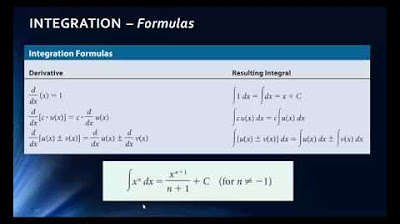Worked examples: interpreting definite integrals in context | AP Calculus AB | Khan Academy
TLDRThe video script discusses two mathematical problems involving definite integrals. The first problem is about Julia's monthly revenue, where the integral from month one to five represents the net revenue increase, adding to the initial $3,000 to total $19,000 by the end of the fifth month. The second problem concerns ketchup production in a sauce factory, where the integral from zero to four hours indicates the total amount of ketchup produced within that time frame. Both problems illustrate how integrals can calculate net changes or total quantities based on rate functions.
Takeaways
- 📈 The revenue function r(t) represents the amount Julia earns in t-th month of the year in thousands of dollars.
- 🚀 The definite integral of r(t) from t=1 to t=5 calculates the net revenue increase from the first to the fifth month.
- 💰 The total revenue by the end of the fifth month is the sum of the initial $3,000 and the area under the revenue rate curve from month one to month five, which equals $19,000.
- 🔢 The expression 3 + the definite integral from 1 to 5 of r(t) dt equals 19 signifies that by the end of the fifth month, Julia has made a total of $19,000.
- 🥫 The function k(t) denotes the amount of ketchup in kilograms produced up to t hours in a sauce factory on a given day.
- 📊 The definite integral from 0 to 4 of k'(t) dt represents the total quantity of ketchup produced from the start to the fourth hour.
- 🏎️ The rate k'(t) is the derivative of k(t), indicating the rate of change in ketchup production with respect to time.
- 🍽️ The integral of the rate function k'(t) does not provide the average rate of change of production, but the total production over the time interval.
- ⏱️ The integral does not indicate the time it takes to produce a specific quantity, such as four kilograms of ketchup.
- 📈 The correct interpretation of the integral from 0 to 4 of k'(t) dt is the total amount of ketchup produced in the first four hours of the day in the sauce factory.
Q & A
What is the meaning of 'r of t' in the context of Julia's revenue?
-In the context of Julia's revenue, 'r of t' represents the rate at which Julia makes revenue each month, where 't' denotes the month of the year.
What does the definite integral from one to five of r of t dt signify?
-The definite integral from one to five of r of t dt represents the area under the rate curve, which indicates the net change in Julia's revenue from the first month to the fifth month.
What is the total revenue Julia made by the end of the fifth month, according to the given expression?
-By the end of the fifth month, Julia had made a total of $19,000, considering the given expression 3 plus the definite integral from one to five of r of t dt equals 19.
How does the definite integral help in understanding the change in revenue over time?
-The definite integral helps in understanding the change in revenue over time by calculating the area under the rate curve, which corresponds to the net increase or decrease in revenue between two specified months.
What does the function k of t represent in the sauce factory scenario?
-In the sauce factory scenario, the function k of t represents the amount of ketchup produced in kilograms as a function of time in hours.
What does the definite integral from zero to four of k prime of t dt signify?
-The definite integral from zero to four of k prime of t dt signifies the total amount of ketchup produced by the sauce factory from time zero to four hours.
Why is the average rate of change of ketchup production not represented by the definite integral from zero to four?
-The average rate of change of ketchup production is not represented by the definite integral from zero to four because the integral represents the total quantity produced over that time period, not the average rate at which it changes.
How can the definite integral be used to calculate the time it takes to produce a certain amount of ketchup?
-The definite integral can be used to calculate the time it takes to produce a certain amount of ketchup by finding the time interval over which the integral equals the desired amount of ketchup produced.
What is the relationship between the function k of t and its derivative k prime of t?
-The function k of t represents the amount of ketchup produced at any given time, while its derivative k prime of t represents the rate at which the amount of ketchup is changing with respect to time.
How does the integral of a rate function differ from the instantaneous rate of production?
-The integral of a rate function, such as r of t dt or k prime of t dt, represents the total accumulated quantity over a time interval, whereas the instantaneous rate of production, like k prime of four, represents the production rate at a specific moment in time.
What is the significance of the definite integral in analyzing production processes?
-The definite integral is significant in analyzing production processes as it provides a quantitative measure of the total output over a specified time period, allowing for comparisons and evaluations of efficiency and productivity.
Outlines
📈 Revenue Analysis of Julia's Business
This paragraph discusses the calculation of Julia's total revenue over a period of five months. It begins with Julia's monthly revenue, denoted as r of t thousand dollars, and the given information that she made $3,000 in the first month. The paragraph introduces a definite integral from one to five of r of t dt, which represents the area under the revenue rate curve, indicating the net change in revenue from the first to the fifth month. The goal is to find the total revenue by the end of the fifth month, which is given as $19,000. The discussion explores different interpretations of the integral and concludes that Julia's total revenue, including the initial $3,000 from the first month, equals $19,000 by the end of the fifth month.
🥫 Ketchup Production Analysis
This paragraph focuses on the analysis of ketchup production in a sauce factory over a four-hour period. The function k of t is introduced, representing the amount of ketchup in kilograms produced over time. The paragraph discusses the concept of the definite integral from zero to four of k prime of t dt, which is the rate of change of the amount of ketchup with respect to time. The integral calculates the net change in the original quantity of ketchup from time zero to four hours. The paragraph then examines various options to determine what the integral represents, concluding that it is the total amount of ketchup produced in the first four hours.
Mindmap
Keywords
💡revenue
💡definite integral
💡rate curve
💡net change
💡ketchup production
💡quantity
💡rate of change
💡average
💡instantaneous rate
💡time zero
💡total
Highlights
Julia's revenue is represented as r of t thousand dollars per month, where t is the month of the year.
Julia made $3,000 in the first month of the year.
The definite integral from one to five of r of t dt represents the area under the rate curve, indicating the net change in revenue from month one to month five.
The total revenue from time zero to the end of the fifth month is $19,000, as the integral represents the additional revenue plus the initial $3,000 made in January.
Choice A is incorrect because it only considers the additional revenue between months one and five, not the total revenue.
The average revenue per month is not $19,000, as the total revenue from the start to the fifth month is $19,000.
Julia made $19,000 in the fifth month is not accurate, as the statement refers to the total revenue from the start to the end of the fifth month, not just the fifth month.
The correct interpretation is that by the end of the fifth month, Julia had made a total of $19,000.
The function k of t represents the amount of ketchup in kilograms produced in a sauce factory by time in hours.
The definite integral from zero to four of k prime of t dt represents the rate at which the amount of ketchup changes over time.
The integral indicates the net change in the original quantity of ketchup from time zero to time four.
The average rate of change of ketchup production over the first four hours is not given by the integral from zero to four of k prime of t dt.
The time it takes to produce four kilograms of ketchup is not represented by the integral from zero to four of k prime of t dt.
The integral from zero to four of k prime of t dt is meant to show the amount of ketchup produced from time zero to time four, not just at t equals four.
The instantaneous rate of production at t equals four is not what the integral from zero to four of k prime of t dt represents.
The amount of ketchup produced over the first four hours is correctly represented by the integral from zero to four of k prime of t dt.
Transcripts
Browse More Related Video

Business Calculus - Math 1329 - Section 2.5 - Marginal Analysis and Differentials

Math 1325 Lecture 12 1

Interpreting definite integral as net change | AP Calculus AB | Khan Academy

Continuous Money Flow: Present Value Problems

Integrals, Population, and Density Functions

Math 1325 Lecture 9 9 - Applications
5.0 / 5 (0 votes)
Thanks for rating: